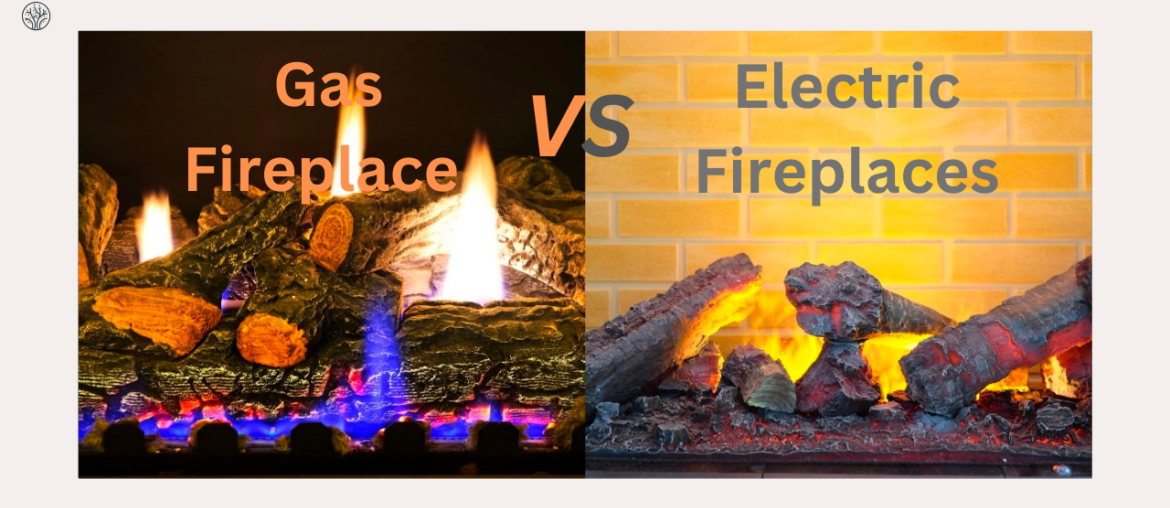When it comes to creating a cozy and inviting ambiance in your home, nothing can rival the allure of a fireplace. The sound of crackling fire and the warm, flickering glow of burning logs are undeniably charming. However, things have been advanced with technology and changing preferences. Traditional wood burning fireplaces have gradually given way to more convenient and efficient options: gas and electric fireplaces. In this article, we’ll compare gas vs electric fireplace options across various aspects to help you determine which is right for your needs.
What Is A Gas Fireplace?

A gas fireplace is a modern heating solution that utilizes natural gas or propane as its fuel source instead of traditional wood. This innovation eliminates the need for logs and also offers several advantages in terms of efficiency and convenience.
One of the most significant benefits of a gas fireplace is its efficiency. Unlike wood burning counterparts, which require constant attention and fueling, gas fireplaces can be controlled with a simple flip of a switch or push of a button. This convenience extends to the heating process as well. Gas fireplaces are efficient at warming up spaces quickly, thanks to the instant ignition and consistent heat output they provide.
What Is An Electric Fireplace?

An electric fireplace is a contemporary heating solution that provides warmth and style without the need for wood or gas. Instead of relying on combustion for heat, electric fireplaces harness the power of electricity to generate a welcoming glow and comforting warmth. These fireplaces are designed to mimic the appearance of wood burning fireplaces. They often come with a screen to project an image of a burning log or LED lights that create a realistic flame effect.
These fireplaces have gained immense popularity in recent years due to their convenience, versatility, and aesthetic appeal. They come in a variety of styles and sizes, ranging from wall-mounted to recessed or even built into furniture. They often come with adjustable heat settings, thermostat controls, and remote control functionality. These features allow you to customize the level of warmth and sound effects according to your preferences. This convenience makes electric fireplaces an excellent option for creating ambiance year-round, regardless of the weather outside.
Gas vs Electric Fireplace: Detailed Comparison
Gas and electric fireplaces are both popular options for heating and adding ambiance to homes. Gas vs electric fireplace, each has its own set of advantages and disadvantages, and here’s a detailed comparison:
Gas Vs Electric FirePlace: Installation
The installation process plays a crucial role in determining the feasibility of a fireplace in your home. Gas fireplaces and electric fireplaces have distinct requirements and considerations when it comes to installation.
- Gas Fireplaces Installation:
Gas fireplaces require a steady supply of natural gas or propane to operate. If you don’t already have a natural gas line, you may need to install one, which might not be feasible in several locations. Propane can be an alternative, but it requires a separate storage tank. Additionally, gas fireplaces need proper venting to release combustion byproducts like carbon monoxide. Vented gas fireplaces must be positioned against an exterior wall for outside exhaust. It’s important to note that ventless gas fireplaces aren’t legal in all states due to safety concerns.
While it’s technically possible to install a gas fireplace on your own, it’s strongly recommended to hire a professional for the job. Working with gas lines requires expertise to prevent potential hazards. It’s easier to install a gas fireplace with the help of a plumber. They can handle the gas line installation, ensuring safety and compliance with regulations.
- Electric Fireplaces Installation:
Electric fireplaces offer a simpler installation process. They only require a standard electrical outlet to function. However, depending on the model and size of the fireplace, you might need to run a new electrical line or even a dedicated circuit. Electric fireplaces don’t produce any emissions, so there’s no need for venting or exterior exhaust. This makes their placement more flexible within your home.
One of the standout advantages of electric fireplaces is their DIY-friendly installation. They often come with the option to plug into existing outlets, making them suitable for homeowners who enjoy taking on small projects. However, if you’re looking to hardwire your electric fireplace into your home’s electrical network, hiring an electrician is advisable, especially for safety and compliance reasons.
Gas Vs Electric FirePlace: Energy Efficiency
Are gas fireplaces efficient? Yes, they are! Gas fireplaces convert energy to produce heat at around 70 to 90 percent efficiency. They are clean-burning and significantly more efficient than traditional wood burning fireplaces.
What about electric fireplaces? Are electric fireplaces efficient? Absolutely! In fact, they take the lead in terms of energy efficiency for several reasons. For instance, consider the electric fireplaces from MagikFlame. These fireplaces have an energy draw as low as 6.6 volts. This not only helps keep your power bills in check but also aligns with environmentally conscious practices. They convert nearly all the electricity they consume into heat, minimizing energy waste. Gas fireplaces, while efficient, lose some heat through the venting process.
Moreover, electric fireplaces employ high-efficiency LED light bulbs to simulate flames, consuming less energy than the gas combustion process used in gas fireplaces. Additionally, many electric fireplaces offer the option to run the flame effect without activating the heater, allowing you to enjoy the ambiance without expending extra energy. In contrast, gas fireplaces burn natural gas to produce a flame. This, obviously, consumes way more energy.
Gas Vs Electric FirePlace: Sustainability
When considering the environmental impact of fireplaces, it’s important to examine their energy efficiency and emissions. Gas fireplaces, often considered a greener alternative to traditional wood burning fireplaces, do have their pros and cons.
On one hand, they eliminate the harmful particulate emissions and indoor air quality issues associated with wood burning. However, gas fireplaces burn natural gas, a non-renewable resource. While they emit less carbon dioxide and other pollutants, they are not entirely free of environmental implications. The extraction, transportation, and combustion of natural gas release greenhouse gases, contributing to climate change. This raises concerns about the overall carbon footprint of gas fireplaces.
On the other hand, electric fireplaces offer a more environmentally friendly alternative. By relying on electricity, these fireplaces sidestep the issues associated with burning fossil fuels. This characteristic leads to a lower carbon footprint, making electric fireplaces a preferred choice for eco-conscious consumers. Moreover, electric fireplaces can be easily powered by renewable energy sources, amplifying their environmental benefits. If your electricity is sourced from renewable energy, such as wind or solar power, you can even further mitigate your fireplace’s environmental impact. So, if you’re looking for a greener lifestyle, it’s better to replace your gas fireplace with an electric fireplace.
Gas Vs Electric FirePlace: Maintenance
Regarding maintenance, electric fireplaces take the lead. They are known for being incredibly low-maintenance appliances. Unlike gas fireplaces, electric ones don’t burn fuel or require ventilation, which greatly simplifies the upkeep process.
Gas fireplaces require more maintenance than electric ones. While they demand less daily cleaning compared to traditional wood burning fireplaces, they do need regular attention. The Health and Safety Executive does recommend that gas units should undergo annual safety and maintenance inspections performed by certified fireplace technicians. These inspections help identify gas leaks, and the units are cleaned to remove dust, pet hair, debris, and other buildup. Additionally, cleaning the flue is necessary about once per year to ensure proper ventilation.
Electric fireplaces, on the other hand, require minimal maintenance. They don’t burn anything, so there’s no need to worry about cleaning out ashes or dealing with soot buildup. The maintenance for electric units usually boils down to replacing bulbs and inspecting wiring. These tasks are considerably simpler compared to the maintenance tasks involved with gas fireplaces.
Gas Vs Electric FirePlace: Safety
Safety should be a paramount concern when deciding on a heating appliance for your home. In this regard, electric fireplaces hold a significant advantage over their gas counterparts. The key distinction lies in the absence of an actual flame in electric fireplaces. While gas fireplaces can produce real flames, electric fireplaces utilize advanced technology to mimic the appearance of a fire without the associated hazards.
Gas fireplaces, while safer than traditional wood burning fireplaces, still present certain risks due to the presence of open flames. Additionally, gas fireplaces can emit noxious fumes like carbon monoxide if not properly installed or maintained. Even though gas leaks are relatively rare, the potential for highly flammable natural gas to escape is a concern. A telltale sign of a gas leak is the smell of rotten eggs emanating from the fireplace.
Electric fireplaces, on the other hand, produce no harmful emissions or noxious fumes like carbon monoxide. However, it’s important to note that electrical fires can occur if the wiring of the fireplace is damaged. Therefore, it’s crucial to learn safety tips/guidelines when using electric fireplaces and maintain the fireplace’s components regularly.
Gas Vs Electric FirePlace: Cost
The cost aspect is where the two types of fireplaces start to diverge significantly. In terms of upfront costs, electric fireplaces take the lead. They generally have lower purchase and installation costs compared to their gas counterparts. You can find electric fireplace units ranging from $250 to $6,200, with installation costs averaging between $150 and $300. However, it’s worth noting that these lower costs come with trade-offs in terms of heat output and authenticity.
Gas fireplaces, while more expensive upfront, offer a more traditional and efficient heating experience. The cost of purchasing and installing a gas fireplace unit can range from $2,000 to $7,500, and professional installation can add another $2,300 to $10,000 to the total. Additionally, gas fireplaces require a fuel source, which can be either natural gas or propane. The ongoing cost of fuel, along with the initial investment, needs to be factored into the decision-making process.
Operating costs for both types of fireplaces depend on factors such as the model’s efficiency, the size of the room, and the local cost of utilities. Gas fireplaces tend to have higher annual operating costs (around $200-$500), while electric fireplaces are estimated to cost around $50-$80 per year. Keep in mind that these figures can vary based on geographic location and utility rates.
Which Fireplace Is For You?
So, gas vs electric fireplace, which fireplace type comes out on top? The answer depends on your priorities and preferences. If you prefer a real flame and don’t mind the higher costs and maintenance responsibilities, a gas fireplace might be the right choice for you. On the other hand, if safety, affordability, and ease of installation are your top priorities, an electric fireplace could be the winner.
In the end, the decision boils down to your specific needs and circumstances. Carefully consider all the factors above before making your decision. Whichever option you choose, both can undoubtedly add a touch of comfort and charm to your home during those chilly months.





